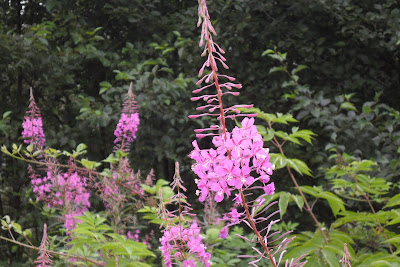On my way to work this morning I drove by this lovely patch of fireweed and I had to stop and take a few photos. Our local fireweed honey is one of my favorites, but the fireweed honey we get in western Washington is rarely pure fireweed honey. There is another honey plant called pearly everlasting whose bloom overlaps the fireweed. Pearly everlasting is a sort of white strawflower that grows up in the mountains and foothills where the fireweed grows profusely. Pure fireweed honey is very light colored and would normally be classed as extra water white on a honey grading scale. Pearly everlasting produces a much darker honey such that even a rather small percentage of pearly everlasting honey mixed with the fireweed darkens the honey significantly. Thus the fireweed honey produced in western Washington is often darker than fireweed from other locales and can vary a bit from year to year in color and flavor.
This is mostly information I have gleaned from several commercial beekeepers who put their bees in the fireweed every year. I have never taken my bees to the mountains and we do not have sufficient quantities of fireweed growing here in the lowlands to produce fireweed honey. What small amount of fireweed honey my bees gather is usually lost in an ocean of blackberry nectar. That being said, I still love to watch the bees working on fireweed blossoms and I have tried to protect it even when it has sprung up in inconvenient locations in our gardens. My wife Linda is less enamoured with the fireweed. She finally lost patience with me this past spring and ripped up most of the fireweed growing in our garden. Based on her description of that task it appears that fireweed has a pretty extensive root system.
My daughter, Rachel, left our beekeeping supply store last year and moved to Oregon. I had to either take on an employee or go crazy being shackled to the bee store all of the time. I hired my good friend Quentin this past January and it has worked out very well for me. I hope it is working out as well for him. He is very good when it comes to woodworking or mechanical things which are very useful skills to have around the bee store. Quentin has also been a very quick study with the bees and I consider hiim to be a fairly knowledgeable beekeeper at this point. He has really taken to the honey and is now a serious honey snob. His absolute favorite honey is our local fireweed. He is positively evangelical when it comes to educating the public about our wonderful local honeys and he is especially delighted when a customer decides that they like the fireweed best. I'm hoping he doesn't suffer a serious crisis of faith if this year's fireweed honey tastes a little different from last year's fireweed.



No comments:
Post a Comment